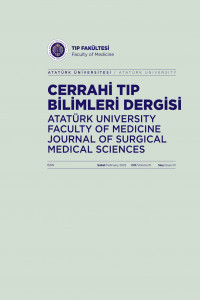KAN-BEYIN VE IRMAK-TOPRAK BARIYERLERI ARASINDAKI MUHTEŞEM BENZERLIKLER ÜSTÜNE DIYALEKTIK BIR METAFOR.
A DIALECTICAL METAPHOR ON THE MARVELOUS SIMILARITIES BETWEEN THE BLOOD-BRAIN AND THE RIVER-LAND BARRIERS
___
- Referans 1. A Prat, K Biernacki, K Wosik, J P Antel: Glial cell influence on the human blood-brain barrier Glia. 2001 Nov;36(2):145-55.
- Başlangıç: 2022
- Yayıncı: Atatürk Üniversitesi
İNTRAPLEVRAL FİBRİNOLİTİK TEDAVİ ETKİNLİĞİ
Mehmet AĞAR, İlham GÜLÇEK, Muhammed KALKAN
TEDAVİDEN TANIYA ABDOMİNAL TÜBERKÜLOZ: OLGU SUNUMU
Vefa ATIŞ, Rıfat PEKSÖZ, Esra DİŞÇİ, Enes AĞIRMAN, Adem ARSLAN
Mehmet Kürşad KARADAĞ, Hakan Hadi KADIOĞLU
Hilal BALTA, Betül GÜNDOĞDU, Nesrin GÜRSAN
SİTUS İNVERSUS TOTALİSLİ HASTADA LAPAROSKOPİK KOLESİSTEKTOMİ: NADİR BİR OLGU SUNUMU
Fuat ŞENTÜRK, Rıfat PEKSÖZ, İlhan YILDIRGAN, Yavuz ALBAYRAK, Esra DİŞÇİ
Mine ÇELİK, Gökçe CİNLİ, Necmiye AY, İlteriş YAMAN, Neslihan KURMAZ
Abdulkerim OLĞUN, Tahsin GÖRGÜLÜ, Ramazan GÜLER, Ahmet Eksal KARGI
Berivan BOZAN, Lale İBRAHİMBEYLİ, Ela Nur MEDETOĞLU, Sümeyye AL, Erkan Cem ÇELİK
